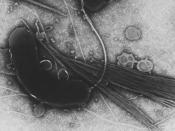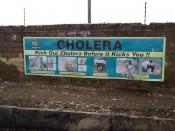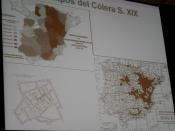Cholera
Chlora is an infection in the small intestine caused by the common shaped bacterium Vibro Cholerae.
It infects your small intestines, causing severe diarrhea, vomiting and leg cramps.You usually get Cholera by swallowing contaminated food or water.
Most of the time people become infected by the bacteria or a diesaster, this is a real danger, since regular food and water supplies are usually unavailable.The diesease can spread even further by people using alrady infected water to wash in, drink from, and use as a toilet.Epidemics usually begin from cases like this.
Cholera has been known in Northeast India for centuries, where outbrakes regulary occur.In the 19th century with the opening of trade routes and the increase in Muslim and Hindu pilgrimages, cholera spread throughtout the world,causing millions of deaths in epidemics.
During the first half of the 20th centuary cholera was confined to Asia but in 1960 the seventh pandemic spread from Indonesia to the rest of Asia, Africa and the Meditteranean coast.
In 1993 a new strain of Cholera, 0139, was identified in Bangladesh as a cause of, potentially the eighth pandemic. Immunity from earlier strains didn't seem to protect against this new one.
A few cases of Cholera occur in the UK.It usually appears mainly among travellers who have been on holiday to Africa, Asia etc.Occasionally outbrakes occur on the Meditteranium borders where the victim has eaten a shellfish, which seem to be capable of harbouring the cholera bacterium.
Symptoms
Cholera can be mild or even without symptoms, but a severe case can lead to a painful death.
It starts suddenly, between one and five days after infection, with diarrhoea, often accompanied with vomiting. More than 500ml of fluid could be lost each hour in the diarrhoea and if it isn't replaced,


